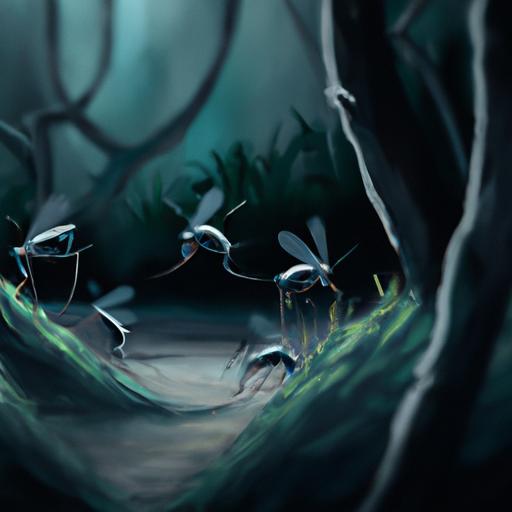Mosquitoes are one of the most annoying pests during the summer months, but did you know that their breeding habits are closely linked to standing water? If you want to reduce the number of mosquitoes buzzing around your property, then you need to learn all about standing water – and how it affects mosquito breeding.
In this article, we’ll cover the basics of standing water and how it relates to mosquito breeding, as well as the risks associated with standing water and what you can do to reduce mosquito breeding in your area.
We’ll also look at alternatives to standing water, and what you should do if you have standing water in your yard.
Read on to learn more about mosquitoes and standing water!
Table of Contents
Short Answer
Mosquitoes need water to breed, but not necessarily standing water.
Female mosquitoes lay their eggs on the surface of the water, but they do not require water to be still for the eggs to hatch.
In some cases, mosquitoes may lay their eggs in damp soil and then floodwater can cause the eggs to hatch.
Mosquitoes can also breed in water that is flowing, such as in streams or rivers.
What is Standing Water?
Standing water is any water that is not moving and is allowed to sit in one place.
This could be a pond, a puddle, or even a clogged gutter.
It is important to note that standing water doesnt necessarily have to be outdoorsit can also be found inside, such as in a birdbath or a bucket of water.
Standing water is the ideal environment for mosquitoes to lay their eggs, as it is the perfect place for the eggs to survive and hatch.
The eggs of mosquitoes are very resilient and can survive for weeks if not submerged in water.
When the eggs are submerged, they hatch into larvae, which feed on organic matter and eventually become adults.
Without standing water, the eggs cannot hatch and the mosquito population cannot increase.
It is important to be aware of any areas of standing water that could be a breeding ground for mosquitoes.
It is best to get rid of any standing water that could be a potential breeding ground for mosquitoes, such as clogged gutters or buckets of water.
Additionally, it is important to keep an eye out for any standing water that may be forming in your yard or neighborhood, as this can also be a potential breeding ground.
How Do Mosquitoes Lay Eggs?

When it comes to mosquito reproduction, female mosquitoes lay their eggs in standing water.
This is because standing water is the most ideal environment for the eggs to hatch as it is protected from the elements and provides enough moisture for the eggs to survive.
Female mosquitoes will lay their eggs in any stagnant water source they can find, including puddles, ponds, and even clogged gutters.
The eggs themselves are quite resilient and can survive for weeks in dry conditions before they are submerged in water.
Once submerged, the eggs quickly hatch into larvae which feed on organic matter and eventually become adults.
Without standing water, the mosquito eggs cannot hatch and the mosquito population cannot increase.
Mosquito eggs also have an interesting ability to sense when the conditions around them are becoming unfavorable and can go into a state of dormancy until better conditions arise.
As soon as the eggs are submerged, however, they will quickly hatch into larvae and continue on the path to adulthood.
In conclusion, mosquitoes do need standing water to breed as this is the ideal environment for their eggs to hatch.
Without standing water, the mosquitoes cannot reproduce and the population cannot increase.
Therefore, it is important to try to reduce the amount of standing water in your yard or garden to help keep the mosquito population down.
What Happens When Mosquitoes Lay Eggs in Standing Water?
When mosquitoes lay eggs in standing water, it provides an ideal environment for them to hatch and develop into larvae, which later become adults.
The eggs are able to resist drying out for weeks before they are submerged in water, and once submerged, they hatch almost immediately.
The larvae then feed on organic matter present in the water, such as bacteria or algae, and eventually develop into adult mosquitoes.
Without standing water, the eggs cannot hatch and the mosquito population cannot increase.
This is why it is important to remove any potential sources of standing water in your yard or home to reduce the number of mosquitoes in your area.
What Are the Risks Associated with Standing Water?

When it comes to standing water, the risks associated with it are manifold.
Not only does it provide an ideal environment for mosquitoes to lay their eggs and hatch into larvae, but it can also be a breeding ground for many other pests, such as flies, midges, and mosquitoes.
In addition, standing water can also serve as a breeding ground for dangerous bacteria and viruses, which can cause a variety of illnesses in humans.
In particular, standing water can be a breeding ground for mosquito-borne illnesses such as West Nile virus, Zika virus, and malaria.
These illnesses can be especially dangerous for young children, pregnant women, and individuals with weakened immune systems.
Furthermore, standing water can also create a favorable environment for the growth of mold, which can cause allergies and other respiratory issues in humans.
Therefore, it is important to take the necessary precautions to prevent the formation of standing water on your property.
This can include clearing away any debris or items that could collect water, such as leaves or plastics, and ensuring that your gutters are not blocked.
Additionally, you can reduce the risk of mosquitoes breeding by using mosquito-repellent plants in your garden, as well as keeping an eye out for any standing water that may have formed in your yard.
What Can I Do to Reduce Mosquito Breeding in My Area?
When it comes to reducing mosquito breeding in your area, there are a few key steps you can take.
First, make sure to check your yard and home for any sources of standing water.
Mosquitoes are drawn to any stagnant water, so be sure to check for any areas where water could be accumulating such as birdbaths, planters, buckets, or other containers.
If you find any standing water, be sure to empty it out and keep it dry.
Also, you can take steps to reduce the amount of mosquitoes around your home by using insect repellent and wearing protective clothing such as long sleeves and pants.
Additionally, you can make sure to keep your windows and doors closed to prevent mosquitoes from entering your home.
Finally, if you live in an area where mosquitoes are particularly bad, you can consider implementing mosquito control measures such as larvicide treatments or insecticide treatments.
These treatments are designed to reduce the number of mosquitoes in your area and can be effective in reducing the risk of mosquito-borne illnesses such as West Nile virus or Zika virus.
By taking these steps, you can help reduce the number of mosquitoes in your area and enjoy a mosquito-free summer.
Alternatives to Standing Water

When it comes to controlling the mosquito population, it is important to understand that standing water is not the only option for them to breed.
Female mosquitoes can lay their eggs in other moist areas such as moist soil, wet leaves, and even in damp dark places such as hollow tree trunks.
Additionally, some species of mosquitoes can even lay eggs in areas that are constantly wet such as streams, rivers, and other slow-moving bodies of water.
To minimize the chances of mosquitoes breeding in alternate areas, it is important to reduce the sources of moisture and stagnant water around your home.
This includes regularly cleaning out gutters and rain barrels, removing any standing water from flower pots, and keeping your yard free of debris or standing water.
Additionally, it is important to keep the vegetation around your home well-trimmed as this can reduce the number of areas where mosquitoes may lay their eggs.
Another important factor to consider is that mosquitoes can travel quite a distance in search of breeding grounds.
This means that even if you are diligent about controlling the breeding grounds on your property, you may still be affected by mosquitoes from nearby areas.
In this case, it is important to take steps to reduce the number of mosquitoes in your area, such as using mosquito traps or sprays, as well as limiting the amount of time you spend outdoors during peak mosquito activity times.
What If I Have Standing Water in My Yard?
If you have standing water in your yard, it may be tempting to let it remain, as it can make a great habitat for birds and other wildlife.
However, if you have standing water, its likely that mosquitoes can use it to breed.
Mosquitoes prefer standing water because its the ideal environment for their eggs to hatch.
If the water is shallow and still, it provides the perfect place for female mosquitoes to lay their eggs, which can survive for weeks until they are submerged in water.
Once submerged, the eggs hatch into larvae, which feed on organic matter and eventually become adults.
Therefore, if you have standing water in your yard, its important to take steps to minimize the amount of standing water and prevent mosquitoes from breeding in it.
Start by removing any items that can collect water, such as tires, buckets, plant pots, and other containers.
If you have a birdbath, make sure to replace the water at least once a week or use an aerator to keep the water moving.
If you have a pond, stock it with fish that can eat mosquito larvae.
Finally, if you have any areas of standing water that cannot be eliminated, consider applying a larvicide to the water to kill the larvae before they can become adults.
By taking these steps, you can help reduce the mosquito population in your yard and minimize the risk of mosquito-borne illnesses.
Final Thoughts
We now know that standing water is a key factor in the breeding of mosquitoes.
Female mosquitoes lay eggs in any stagnant water they can find, which can cause a rapid increase in the mosquito population.
To reduce the risks associated with standing water and lower the mosquito population, it is important to remove any standing water from your property.
If you can’t remove the water, consider alternatives such as using mosquito dunks or larvicides.
By taking the necessary steps to reduce standing water on your property, you can help reduce the mosquito population in your area.

